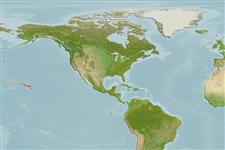Teleostei (teleosts) >
Perciformes/Serranoidei (Groupers) >
Anthiadidae (Fairy basslets or Streamer basses)
Etymology: Pseudanthias: Greek, pseudes = false + Greek, anthias = a fish, Sparus aurata (Ref. 45335).
More on author: Randall.
Environment: milieu / climate zone / depth range / distribution range
Ecology
Marine; reef-associated; depth range 26 - 68 m (Ref. 10382). Tropical
Eastern Central Pacific: Hawaii and Johnston Island.
Size / Weight / Age
Maturity: Lm ? range ? - ? cm
Max length : 7.7 cm SL male/unsexed; (Ref. 10382)
Dorsal spines (total): 10; Dorsal soft rays (total): 16 - 18; Anal spines: 3; Anal soft rays: 9 - 10. This species has the following characters: body depth 2.6-2.95 in SL; scaled lower jaw; absence of fleshy papillae on edge of orbit; upper edge of preopercle finely serrate while the lower edge is smooth; margin of subopercle serrate while interopercle has 0-4 serrae; in males the front of upper lip is not thickened nor pointed and the anterior soft part of the anal fin more prolonged, fourth anal soft ray longest; caudal fin deeply emarginate with filamentous lobes; pelvic fins long, very long in males; colour of females yellow dorsally, shading on body to lavender-pink, but scale centers yellow; head yellow with pink to magenta lines; fins are yellow, the dorsal and anterior anal fin with magenta margin; color of head of males similar to females but body orange with red scale centers, changing to violet posteriorly; dorsal and anal fins are mainly orange, abruptly pale yellow posteriorly; a large magenta-edged yellow spot at base of pectoral fins (Ref. 86689).
Life cycle and mating behavior
Maturity | Reproduction | Spawning | Eggs | Fecundity | Larvae
Randall, J.E., 1979. A review of the serranid fish genus Anthias of the Hawaiian Islands, with descriptions of two new species. Contrib. Sci. Natur. Hist. Mus. Los Angeles County 302:1-13. (Ref. 10382)
IUCN Red List Status (Ref. 130435: Version 2024-2)
Threat to humans
Harmless
Human uses
Tools
Special reports
Download XML
Internet sources
Estimates based on models
Phylogenetic diversity index (Ref.
82804): PD
50 = 0.5000 [Uniqueness, from 0.5 = low to 2.0 = high].
Bayesian length-weight: a=0.01349 (0.00618 - 0.02945), b=3.00 (2.81 - 3.19), in cm total length, based on LWR estimates for this (Sub)family-body shape (Ref.
93245).
Trophic level (Ref.
69278): 3.3 ±0.4 se; based on size and trophs of closest relatives
Resilience (Ref.
120179): High, minimum population doubling time less than 15 months (Preliminary K or Fecundity.).
Fishing Vulnerability (Ref.
59153): Low vulnerability (10 of 100).
